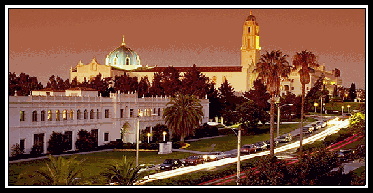
URBAN ECONOMICS
 |
| Spring 2003 |
 |
Economics 104 URBAN ECONOMICS |
|
|
|
| | HOME | SYLLABUS | CALENDAR | ASSIGNMENTS | ABOUT PROF. GIN | |
DATE: February 24, 2003 TO: FROM: Alan Gin, Director SUBJECT: Economic Impact Analysis I would like to take this opportunity to welcome you as a new employee of the City of Alantown. I am sure that you will make a strong contribution to the well-being of this city in your position of economic analyst. I understand that, while at the University of San Diego, you studied under one of top people in the field. Through our economic development efforts, we have been able to convince one of the nation's largest peanut butter manufacturers to locate a plant in our city. The plant will bring 1,000 new export sector jobs to the city and will pump $30,000,000 into the local economy. Because of your expertise, your first assignment will be to determine the impact of the firm locating in our city. I'd like you to determine the impact by using economic base analysis. Please use the following procedures: First, gather data for employment for the county where this city is located. Employment data is available on the Internet from the following Websites:
Enter the data into the computer software the city has bought for you. After the data is entered, use the output from the software to conduct a three-part analysis as indicated below: I. Local Economy Identify the top 5 industries in the private sector in terms of the number of export jobs, and the top 5 industries in terms of concentration, as measured by the location quotient. II. Economic Base Analysis Calculate the multiplier for the county. Use the multiplier to determine the total number of jobs created and the total increase in income in our city that results from the plant locating here. III. Demographic Analysis Determine the impact of the increased economic activity on the variables below, using the given assumptions which were determined by our demographics department: 1. Population - 2.2 people for each additional worker 2. Number of households - 2.8 people in each household 3. Housing units - 1.03 housing units required for each household 4. Automobile ownership - 1.2 cars per household 5. Annual vehicle miles - 12,000 miles per year per car 6. Peak-hour trips - 0.6 peak-hour trips per household 7. Number of students - one school-aged child for every two households 8. Daily water consumption - 150 gallons per person per day IV. Fiscal Analysis Determine the fiscal impact of the plant, based on the following assumptions: Revenue: 1. Property taxes - Each housing unit has an average assessed value of $150,000. The city receives 1% of the assessed value in property taxes. 2. Sales taxes - It's been estimated that 45% of income is spent on taxable retail sales. The city receives 1% of taxable retail sales in sales taxes. 3. Fees - The average number of workers per firm in the city is 25. Each firm pays an average of $5,000 a year on various fees and assessments. Expenditures: 1. Police - The police department has a standard of maintaining 2 police officers for every 1,000 residents. Figuring all the costs involved, it is estimated that the city will have to spend $90,000 per officer per year for salaries, benefits, support, etc. For every 5 police officers, we need to spend $35,000 to buy another police car. 2. Fire protection - The fire department has a standard of maintaining 1 firefighter for every 500 housing units. Figuring all the costs involved, it is estimated that the city will have to spend $80,000 per firefighter per year. For every 8 firefighters, we need to spend $100,000 to buy a fire truck. 3. Road maintenance - The public works department estimates that, for every 100,000 miles driven on city streets, a pothole develops. For every 250 potholes that develop, a road maintenance worker must be hired at a total cost of $45,000 per year. Also, the streets must be widened in some areas by one lane for each additional 1,000 trips made during the rush hour. This involves a one-time cost of $1,000,000 for each additional lane built. 4. Schools - The education department estimates that a new school must be built for every 600 new students. Each school costs $5,000,000 to build. There are 24 teachers in each school earning a total of $50,000 a year each in salary and benefits. Each school also has a principal ($85,000 per year), an assistant principal ($70,000), a counselor ($55,000), two administrative assistants ($35,000 each), and two maintenance people ($40,000 each). Operating expenses above salaries are $300,000 a year. Each school’s share of state education funds is $3,100 per student enrolled. 5. Water - The water department indicates that any additional water requirements would have to be met by buying and importing water from outside the region. To import additional water, the pipes bringing the water into the region have to be upgraded at a one-time cost of $1,000,000 for every 500 acre-feet of water imported each year (there are 326,000 gallons of water in an acre foot). The cost to buy each acre-foot is $500. Indicate the cost of capital projects (one-time costs) as well as the annual operating costs for each department. When reporting the costs, show what the money will buy. Please prepare a report on the impact of the peanut butter manufacturing plant. The report should be typed on 8 1/2 by 11 paper. I need a forecast of the economic impact for the city council meeting on Wednesday, April 16, so you'll need to complete the report on or before that date. If you don't, I forecast that unemployment in the city will increase by one. |